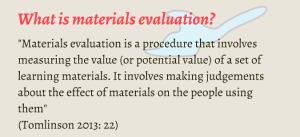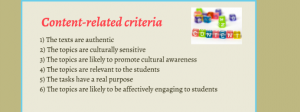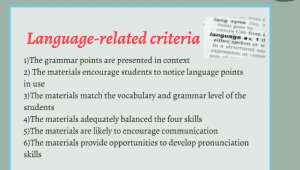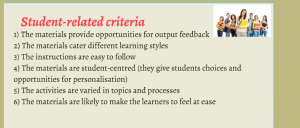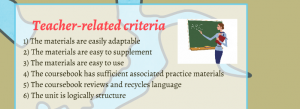Adapting and supplementing
Every institution tries to choose the best suitable course book but yet, it won’t work without adapting or supplementing, even if it was designed locally or by the institution itself for its own use, as many schools tend to do nowadays, simple because there are no identical learners, needs or teachers.
Every teacher adapts materials to suit his/her learners’ needs by using a number of techniques: modernizing, simplifying, personalizing, localizing, editing or expanding, Elis,M(1986:47).
Sometimes we have to adapt materials simply because they are out of date or they aren’t culturally or politically sensitive, lacking on authenticity, to make sure that they met learners’ and teachers’ needs.
There are various forms of adaptation: extemporisation,extension,exploitation.
Extemporisation, usually oral and spontaneous. It quite often takes place, when you have to cover the class you are unfamiliar with ,or there are a lot of new students and their abilities or needs don’t match to what you have or prepared to teach.
Extension, providing additional material. e.g. an extra grammar exercise from another source. Personally, I can’t imagine a lesson without extension as there are never enough of activities or tasks for learners to understand and learn the new piece of material unless it’s personally designed for a particular learner group.
Exploitation. Creative way of presenting materials.
Deleting or omitting materials
Rewriting, making it more personal, communicative.
Reordering. There are some course books that don’t follow the rules of second language acquisition: e.g. present simple is given before present continuous and etc.
Adapting is incredibly important in teaching or any other industries as we all try to make our work more relevant to our learners, customers, and etc.
It’s always easier and more effective to follow some patterns, rules or frameworks when selecting a coursebook, designing, adapting or supplementing materials . I found the following framework from McDonough, Jo(2013:77) handy and easy to follow:
1. Adding
2. Deleting or omitting
3. Modifying
4. Simplifying
5. Re-ordering
Why supplementing?
Teaching is a creative process and it’s impossible to get away with only adapting materials.
Learners and teachers themselves always need something new, effective, fun, vibrant, tailored, catering their needs, demand and popularity for blended learning. Supplementing is crucial as it helps to fill in the gaps in a course book or syllabus , make learning more fun, boost motivation, especially at exam preparation, when the activities can be pretty daunting. Why not throw some worksheets, videos or even computerized worksheets to bring in some fresh air for students or teachers themselves when lacking in motivation and feeling tired with doing the activities, which are dull or not working for learners.
Supplementing by using published materials is quick and easy but not necessarily as effective as designing own material, which can be time-consuming but worthwhile. It’s vital to follow principles for developing materials when trying to design own worksheet for supplementing or using ready materials to ensure that it does do the job, not just irrelatively feeling the gap. It’s hard to find a ready material to tick off all the boxes, such as meeting your learners’ needs, their aptitude, level age and so on. Being very busy it’s unrealistic to have always your own worksheets but it’s necessary to adapt, supplement, omit or changed published material to make it suitable for your learners.
This summer I have mainly worked with young learners aged between 14-18 years old from Germany, Italy and Eastern Europe. Each group came for two to three weeks . I discussed and analyzed learners needs with each group, and the students wish was: to brush up grammar(we agreed on what they would like to be covered), have fun dynamic lessons, plenty of speaking, videos, games and no books. I wasn’t put off by my learners rejecting the use of the coursebook we were giving as I like being eclectic and try to choose the topics which are interesting for the learners in order to make it engaging and fun.
As I have mentioned earlier the learners I worked with had a strong knowledge of grammar and they wanted simply revise it to make sure there are aren’t any gaps or they use it correctly and do it in a communicative way.
Here is the example of supplementing and adapting to the second condition for English file pre-intermediate group of students. I decided to go simple, considering the level of the group and chose the theme for the grammar point: ‘ What would you do if……?’ Also, as I have mentioned earlier the students weren’t very eager on using the book, so I decided to use only p.66 from Unit 6 and supplement it with various activities.
1. In a group of four or five students had to imagine that they are on the boat in the open sea and they had time to take only five things with them before their boat sank.
2. Students had to decide on the items in their groups and then had to justify their chose before the class and the rest of the class had to comment on their decision.
blog
3. After that, each group had to choose the cutout situations and see if they would survive on the island with the items they chose. It was very fun activity and sparked a lot of discussions, debate and practice of grammar point as the students tried to come up with the ideas how they would survive on the island full of snakes or zombies.
4. At the next stage, the students had to speculate about the images, guess where this place is and what things, animals, insects they have to be aware of when visiting those places.


5. Next, the learners were given a ‘survival test’ from New English file page 66(I have noticed that any quiz or test always works really well with all learners, especially teenagers, and they find it very engaging. Students had to do the test in their groups and then compare their answers with other groups, trying to work out the right answer. After that, the learners were given the correct answers and we revised the form.
6. In order to make sure that the learners got the form and used it correctly and ‘fluently, naturally’, I came up with the next activity using a video: ‘ The Blackhole’, which I came across on Facebook.
7. First, I elicited what they know about the black holes and what they are.
8. Next students watched the video and had to guess what a man from the video would do with the black hole.
9. After the learners finished watching the video, they were given an image of the black hole >>IMAGE and had to discuss in their groups what they would to with it if they had one. It was a great opportunity to practice the form, the students were carried away by their imagination that it didn’t feel like practicing the grammar point. They came up with various ideas, such as they would use it to through in all the rubbish when tidying up the room, a disposal for annoying boy/girlfriends, traveling, even using for lessons.
Sum up:
Did this supplementation work? I think yes. I did it to:
a) Provide additional material to practice the form
b) It was fun, more personal, student-centered(not only increasing the learners speaking time but also meeting their interests and needs, came up with the activities they like and enjoy).
c) Made it more communicative allowing plenty of opportunities to practice the form.
Bibliography:
McDonough, J., et al. (2013) Materials and Methods in ELT: A Teacher’s Guide. Chichester: Wiley-Blackwell.
McGrath, I. (2002) Materials Evaluation and Design for Language Teaching. Edinburgh: Edinburgh, University Press
McGrath, I. (2013) Teaching Materials and the Roles of EFL/ESL Teachers: Practice and Theory. London: Bloomsbury.
Mishan, F. & Timmis, I. (2015) Materials Development for TESOL. Edinburgh: Edinburgh University Press.



